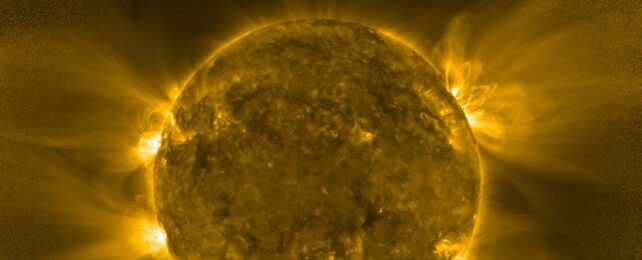There's something really odd about the Sun.
Actually, there's a lot of odd somethings about the Sun, but a ground-breaking space probe has just given us the clue we might need to solve one of them. New observations from the European Space Agency's (ESA) Solar Orbiter suggest that the constant reconnection of tiny magnetic field lines may be at least part of the reason why some parts of the Sun are so much hotter than others.
"It's a star," you are no doubt thinking. "Of course it is hot."
The problem is the surface of the Sun is around 5,500 degrees Celsius (9,932 Fahrenheit) – a normal temperature for a Sun-like star. But the material in its atmosphere only grows hotter with distance from the surface, peaking at a baffling 2 million degrees Celsius in the uppermost reaches known as the corona.
We've known about this coronal temperature inversion since the 1940s, and it's thought to be a common feature in stars. But what scientists have been unable to determine is why.
One of the leading candidates to explain this phenomenon is constant, small-scale magnetic reconnection.
At least on the large scale, magnetic reconnection is a well documented solar behavior. Most stars are roiling, turbulent balls of incredibly hot plasma; a fluid made up of charged particles that interacts strongly with electromagnetic forces. That means objects like our Sun are positively bristling with extremely complicated and messy magnetic fields.
Beyond the innermost layer of the Sun's atmosphere, known as its photosphere, these magnetic field lines can tangle, stretch, snap, and then reconnect. This produces an enormous burst of energy – the engine that powers solar flares and coronal mass ejections that send particles blasting through the Solar System.
On smaller scales, scientists believed that these reconnection events would inject energy into the corona, thus providing it with a source of heating. But the Sun is very hot and bright, which makes it hard to observe; we simply didn't have enough resolution to see the small scales on which this process would be occurring.
This is where Solar Orbiter enters the picture. ESA's solar probe launched in February 2020, and has been getting up close and personal with our home star, zooming in to perilous closeness in a series of looping encounters to study its activity in spectacular detail.
As the spacecraft closed in for its first close approach, it caught sight of something amazing. On 3 March 2022, ultra-high resolution images in extreme ultraviolet wavelengths revealed magnetic reconnection happening on absolutely tiny scales (for the Sun) – just 390 kilometers (242 miles) across.
That's actually incredible. Scientists were able to resolve and study a phenomenon a little smaller than the length of the Grand Canyon on the surface of the Sun.
Over the course of an hour, the spacecraft recorded a point known as the null point, where the intensity of the magnetic field drops to zero. This is the point of magnetic reconnection. Over this time frame, the temperature of the null point was maintained at around 10 million degrees Celsius. The null point also produced a continuous outflow that streamed away at speeds of around 80 kilometers per second, visible as "blobs" of plasma.
This is what is known as "gentle" reconnection, but the null point also exhibited a phase of more violent reconnection. This explosive reconnection only lasted for about four minutes, but it showed that the two kinds of reconnection are happening simultaneously, and at scales smaller than we'd previously been able to resolve.
These two types of reconnection would transfer mass and energy to the corona above them, providing a source of heat that could account for at least some of the poorly understood temperature inversion.
The findings also suggest that reconnection may even be occurring on scales too small for Solar Orbiter to resolve, at least on that close approach. The next several, as well as the one that just took place on 10 April, will be zooming in even closer, which may lead to even more high resolution observations.
Meanwhile, we have our first observational evidence that constant, small-scale magnetic reconnection is taking place on the surface of the Sun, validating a long-held hypothesis about, and taking us a step closer towards solving, how the corona is heated.
The research has been published in Nature Communications.
